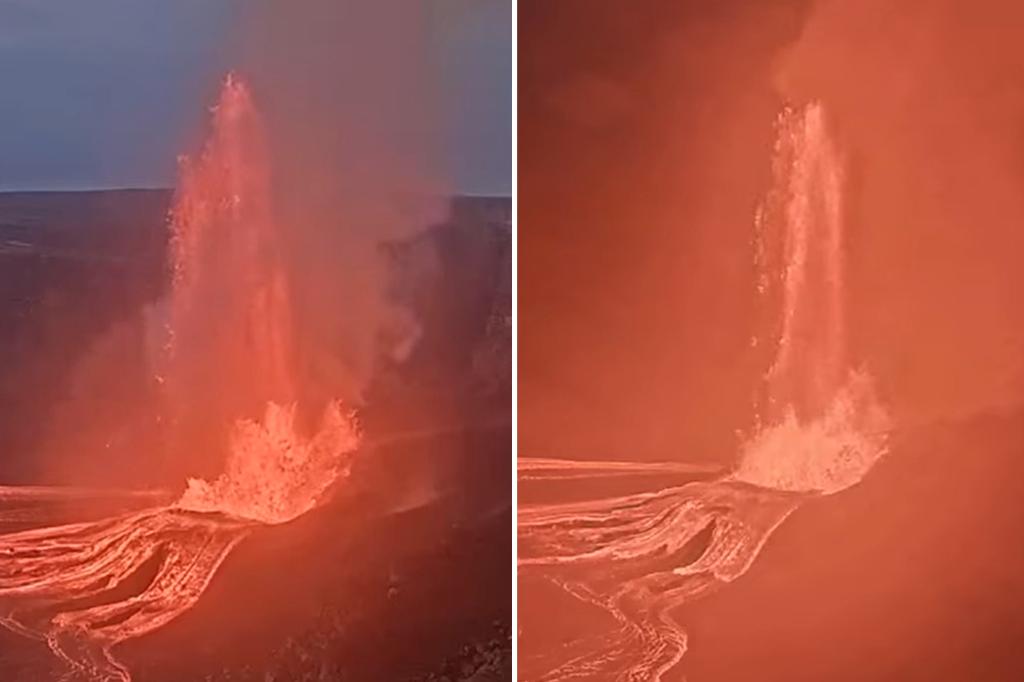Kilauea’s Fiery Resurrection: A Spectacle of Nature’s Power
Hawaii’s Kilauea volcano erupted spectacularly on June 3, 2024, sending molten lava soaring 650 feet into the air and illuminating the night sky with an ominous orange glow. The eruption, occurring in Halemaʻumaʻu crater within Hawaii Volcanoes National Park, marks the volcano’s most vigorous activity since 2018, captivating scientists and tourists alike while raising concerns about potential impacts on local communities and fragile ecosystems.
The Eruption’s Dramatic Onset
At approximately 4:17 p.m. HST, seismic monitors detected a sudden increase in earthquake activity beneath Kilauea’s summit. Within hours, fissures split open the crater floor, unleashing fountains of lava that reached heights equivalent to a 60-story building. The U.S. Geological Survey’s Hawaiian Volcano Observatory (HVO) reported:
- Lava fountains initially reached 200-300 feet before peaking at 650 feet
- The eruption created a new lava lake covering 140 acres
- Sulfur dioxide emissions spiked to 65,000 tonnes per day
“This is Kilauea reminding us who’s really in charge,” said Dr. Lani Kapono, a volcanologist with the HVO. “The sheer energy displayed during these initial hours rivals some of the most intense phases of the 1959 Kīlauea Iki eruption.”
Scientific Significance of the Eruption
The current eruption provides researchers with a rare opportunity to study Kilauea’s magmatic system in real time. Advanced monitoring equipment installed after the destructive 2018 eruption offers unprecedented data collection capabilities:
Ground deformation measurements show the summit area inflated by nearly 5 inches prior to the eruption, indicating substantial magma accumulation. Thermal cameras recorded lava temperatures exceeding 2,140°F (1,170°C), suggesting the emergence of particularly hot, fluid magma from deep sources.
“We’re seeing textbook examples of effusive eruption dynamics,” noted Dr. David Okamoto, a geophysicist at the University of Hawaii. “The lava’s chemical composition appears different from recent eruptions, which could signal changes in the volcano’s plumbing system.”
Community Impact and Safety Measures
While the eruption remains contained within the national park, authorities have implemented several precautionary measures:
- Closure of several park trails and viewpoints
- Air quality alerts for downwind communities
- Emergency preparedness notifications for adjacent districts
Local businesses report mixed reactions to the volcanic activity. “Tourism bookings jumped 300% overnight,” said Maile Tanaka, owner of a Hilo tour company. “But we’re also fielding calls from nervous residents remembering 2018.” That year, Kilauea’s lower East Rift Zone eruption destroyed over 700 homes.
Ecological Consequences and Adaptation
The eruption’s environmental impacts present both destruction and renewal. Lava flows have:
- Incinerated approximately 90 acres of native ʻōhiʻa lehua forest
- Created new terrestrial habitats that will eventually support unique ecosystems
- Temporarily displaced endangered nēnē (Hawaiian geese) from nesting areas
Botanist Dr. Noelani Pualani explains: “While immediate losses appear devastating, volcanic events drive Hawaii’s ecological evolution. The new mineral-rich surfaces will foster specialized plant communities over decades.”
Monitoring and Future Projections
Scientists emphasize that Kilauea’s activity remains unpredictable. Current models suggest three possible scenarios:
- Best case: Eruption continues at current intensity for weeks before gradually waning
- Moderate scenario: Activity migrates to new fissures, expanding the affected area
- Worst case: Connection with deeper magma sources triggers prolonged, more explosive eruptions
The HVO maintains 24/7 monitoring, with over 60 seismic stations and gas sensors tracking minute changes. “We’ve entered a new phase of Kilauea’s centuries-long eruption cycle,” said observatory director Dr. Susan Carter. “While beautiful, this demands respect and vigilance from all of us.”
Living With an Active Volcano
For Native Hawaiians, the eruption holds deep cultural significance. “Pele is cleansing and creating,” said cultural practitioner Kawaipono Kealoha. “We honor this process that shaped our islands and continues to define our relationship with the land.”
Meanwhile, emergency managers use this event to test improved response systems developed after 2018. Enhanced communication networks and updated evacuation plans aim to better protect communities should activity escalate.
Conclusion: A Reminder of Nature’s Power
Kilauea’s spectacular eruption serves as both a breathtaking natural phenomenon and a sobering reminder of volcanic hazards. As scientists work to unravel its mysteries and communities adapt to its impacts, the world watches nature’s raw power unfold in real time. The eruption’s duration and ultimate effects remain uncertain, but its lessons about preparedness and resilience will undoubtedly endure.
For real-time updates and safety information, visit the USGS Hawaiian Volcano Observatory website.
See more Your Daily Weather


